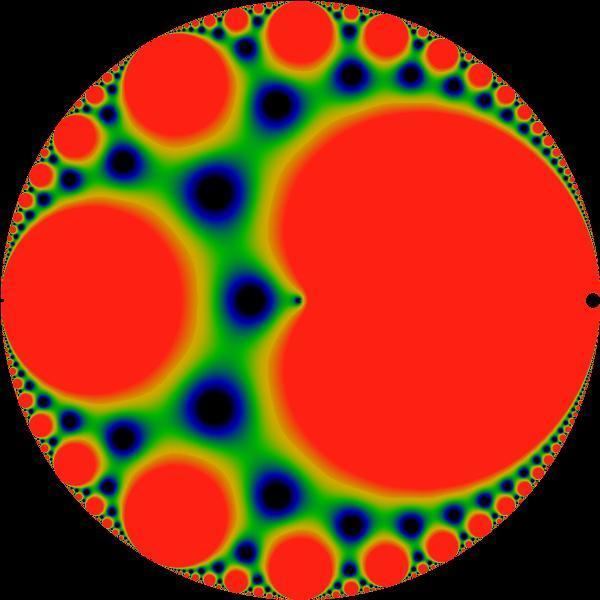 | ||
In mathematics, the Poincaré metric, named after Henri Poincaré, is the metric tensor describing a two-dimensional surface of constant negative curvature. It is the natural metric commonly used in a variety of calculations in hyperbolic geometry or Riemann surfaces.
Contents
- Overview of metrics on Riemann surfaces
- Metric and volume element on the Poincar plane
- Conformal map of plane to disk
- Metric and volume element on the Poincar disk
- The punctured disk model
- Schwarz lemma
- References
There are three equivalent representations commonly used in two-dimensional hyperbolic geometry. One is the Poincaré half-plane model, defining a model of hyperbolic space on the upper half-plane. The Poincaré disk model defines a model for hyperbolic space on the unit disk. The disk and the upper half plane are related by a conformal map, and isometries are given by Möbius transformations. A third representation is on the punctured disk, where relations for q-analogues are sometimes expressed. These various forms are reviewed below.
Overview of metrics on Riemann surfaces
A metric on the complex plane may be generally expressed in the form
where λ is a real, positive function of
The area of a subset of the complex plane is given by
where
A function
The Laplace–Beltrami operator is given by
The Gaussian curvature of the metric is given by
This curvature is one-half of the Ricci scalar curvature.
Isometries preserve angles and arc-lengths. On Riemann surfaces, isometries are identical to changes of coordinate: that is, both the Laplace–Beltrami operator and the curvature are invariant under isometries. Thus, for example, let S be a Riemann surface with metric
with
Here, the requirement that the map is conformal is nothing more than the statement
that is,
Metric and volume element on the Poincaré plane
The Poincaré metric tensor in the Poincaré half-plane model is given on the upper half-plane H as
where we write
for
and
The infinitesimal transforms as
and so
thus making it clear that the metric tensor is invariant under SL(2,R).
The invariant volume element is given by
The metric is given by
for
Another interesting form of the metric can be given in terms of the cross-ratio. Given any four points
Then the metric is given by
Here,
The geodesics for this metric tensor are circular arcs perpendicular to the real axis (half-circles whose origin is on the real axis) and straight vertical lines ending on the real axis.
Conformal map of plane to disk
The upper half plane can be mapped conformally to the unit disk with the Möbius transformation
where w is the point on the unit disk that corresponds to the point z in the upper half plane. In this mapping, the constant z0 can be any point in the upper half plane; it will be mapped to the center of the disk. The real axis
The canonical mapping is
which takes i to the center of the disk, and 0 to the bottom of the disk.
Metric and volume element on the Poincaré disk
The Poincaré metric tensor in the Poincaré disk model is given on the open unit disk
The volume element is given by
The Poincaré metric is given by
for
The geodesics for this metric tensor are circular arcs whose endpoints are orthogonal to the boundary of the disk.
The punctured disk model
A second common mapping of the upper half-plane to a disk is the q-mapping
where q is the nome and τ is the half-period ratio. In the notation of the previous sections, τ is the coordinate in the upper half-plane
The Poincaré metric on the upper half-plane induces a metric on the q-disk
The potential of the metric is
Schwarz lemma
The Poincaré metric is distance-decreasing on harmonic functions. This is an extension of the Schwarz lemma, called the Schwarz–Ahlfors–Pick theorem.
